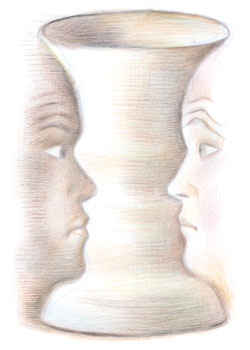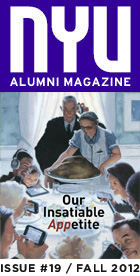behavioral science
Winning the Race
As the first African-American president runs
for reelection, researchers examine
the subliminal influence of political ads
by Andrea Crawford
In 1990, longtime North Carolina Senator Jesse Helms was trailing challenger Harvey Gantt, an African-American who supported affirmative action, when the Helms campaign produced the infamous “hands” commercial. As the camera focused on the hands of a white person holding a letter, the narrator said: “You needed that job, and you were the best qualified, but they had to give it to a minority.” Helms went on to win the election. In another famous appeal, an ad for the 1988 Republican presidential candidate George H.W. Bush featured the menacing mug shot of convicted murderer Willie Horton. The spot explained how the African-American had committed assault while on furlough from a Massachusetts prison—a program supported by Michael Dukakis, the state’s governor and the Democratic presidential candidate. Bush won the presidency in a landslide.
In another famous appeal, an ad for the 1988 Republican presidential candidate George H.W. Bush featured the menacing mug shot of convicted murderer Willie Horton. The spot explained how the African-American had committed assault while on furlough from a Massachusetts prison—a program supported by Michael Dukakis, the state’s governor and the Democratic presidential candidate. Bush won the presidency in a landslide.
It was into this environment that Charlton McIlwain, associate professor of media, culture, and communication at the Steinhardt School of Culture, Education, and Human Development, came of age. These types of appeals clearly work, he thought, and he set out to determine how and why. Around the same time, David Amodio was first exploring research that showed self-avowed egalitarians actually exhibited unconscious biases. Now an NYU associate professor of psychology and neural science, he began his career asking how such automatic types of prejudice could exist in opposition to one’s beliefs. Until recently, these kinds of questions were complicated by a reliance on often-flawed self-reports—people simply feel uncomfortable admitting bias and are sometimes not even conscious of it. But today, McIlwain and Amodio have come together in a timely pursuit. As the first African-American president runs for reelection, they are investigating the power of racial appeals in political ads by turning to neuroscience.
The amygdala, a part of the brain linked to processing fear and threat, activates within milliseconds of seeing a black face.
Because regions of the brain process information in different ways, neuroimaging techniques that record psycho-physiological and neurological responses now offer scientists new ways of understanding our response to stimuli. In their study’s initial phase, McIlwain and Amodio have used electroencephalography to measure brain activity as well as electromyography, which records micro-movements in muscles as people view political ads with either overt or subtle racial messages. They next plan to measure skin conductance to reveal small changes in perspiration on the fingertips and palms, which indicate different response channels of the autonomic nervous system, the involuntary and mostly unconscious system that regulates many organs and muscles in the body and triggers the so-called “flight or fight” response. “It could be your explicit thoughts about the ad that matter most,” Amodio says. But he cautions that many people vote their “gut feeling,” which is essentially now a measurable reaction associated with autonomic arousal. “If the Obama and Romney campaigns are smart, they should have teams of people working on this sort of thing already,” Amodio adds. “We just don’t know about it because those people don’t publish in scientific journals.”
McIlwain, the co-author of Race Appeal: How Candidates Invoke Race in U.S. Political Campaigns (Temple University Press), has seen research over the past decade prove that explicit racial appeals don’t usually work because they violate social norms of equality. But he has observed an uptick in racial rhetoric and depictions in the past few years, especially during the Tea Party and health-care debate protests. These references—which have included President Barack Obama portrayed as a monkey—become considerably easier to make when a candidate, says McIlwain, can “get a third party to do [their] dirty work.”
Amodio notes that psychologists found long ago that after seeing the face of a black person flashed subliminally before them, American subjects, whether black or white, would identify negative words more quickly than positive ones. And recent neuroimaging has shown that the amygdala, a part of the brain linked to processing fear and threat, activates within milliseconds of seeing a black face. His advice: “If you’re a white candidate running against a black one, you could probably be quite successful in running a lot of fear-based ads.”
This is why Jay Van Bavel, assistant professor of social psychology, calls McIlwain and Amodio’s collaboration “extremely important…not only to uncover exactly when these types of ads are working but also to figure out ways to counteract them.” In his own work, Van Bavel has found that the amygdala responds to emotional significance, and when a relationship changes, the autonomic response to that person changes as well. “The moment you’re part of a mixed race team, suddenly you feel positive toward black and white team members,” he explains. “It really seems to be something like ‘who’s with me’ versus ‘who’s against me.’ ”
He believes that this provided a huge boost in the 2008 election for Obama, who used far more collective pronouns (we, us, our) than his opponents: “Whether it was conscious or not, he was basically helping people feel like they’re all part of the same group.” If he can do that again, Van Bavel says, it may “help override some of the racial biases that certain political groups are going to try to cultivate.”
Amodio is less optimistic. He believes that impulses registered in the brain’s amygdala are indelible, but that a candidate may appeal to people to act more in line with their beliefs. “The best strategy for overcoming these automatic responses is likely teaching people to be really effective at controlling [them],” he says. “And the human brain is great at that.” McIlwain says that public vigilance is essential, and sees progress in today’s media compared to 24 years ago, when the discussion over the Willie Horton ad involved some commentators saying it had a racial overtone and others arguing it did not. McIlwain says: “If we’re going to have a debate about whether and when [racism] rears its head in an election, then people need to be educated about how to make that determination.”







